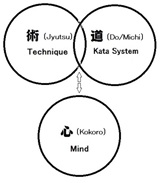|
Doinho
Doin-ho (hereafter referred to as Doin) was incorporated into my technique system as an auxiliary method of karate training. Currently,
I use it as to start my training. However, I haven’t used Doin as much other techniques, partly because I haven’t included it in my technical course.
The reason for this is that Doin is not something that should be forced upon you, but rather something that you should be interested in and work on spontaneously.
Individual differences dictate how receptive we are to Doin.
Now, I would like to briefly summarize the explanation of Doin from my karate point of view, looking back at what I have learned in the past.
Origin
Doin has its origins in “yojyoho.” Yojyoho is defined as a method of circulating qi in the body to prevent illness. It helps to achieve a healthy, disease-free state—one that is consistent with nature.
There are two types of Yojyo-ho: Seiko-ho (Zen meditation) and Doko-ho (walking meditation/hozen, work/samu). Over time, several forms of Doko-ho were created,
and to these forms were added ideas from East Asian medicine, yin-yang studies, etc., involving "qi, blood, water" and "meridians/keiraku" as the essence.
Today they are called "Qigong" or "Doin-ho" (Doin-jyutsu).
The Beginning
It all started when Aiki-jyujutsu’s Sugawara Gesshu-Sensei recommended practicing Hachidankin as an aid to learning how to develop breathing power (1974).
I had been doing self-taught jikyojutsu (a health exercise created by Fusagoro Nakai, a manual therapist, in 1916),
so I was able to learn Hachidankin with little problem. In the same way,
I was able to learn the "Shaolin Isshi-zen," "Rakan-Hachidoko" and "Rakan-Ekkingyo," which I encountered later, with a strange feeling of:
"I have done this before.” I was able to learn these easily.
I think the memory of having done this before came from a two-week Zen practice (1973) at Ryutaku-temple (Rinzai sect) in Mishima City, Shizuoka.
I also felt that in Doin there was a world of Zen practice in which "the work of the mind is concentrated; the heart is quiet and unmoved."
Purpose
Doin is based on putting the consciousness on the breath and letting the qi circulate in every
part of the body.
(1) You train the tanden in order to be able to respond to the sharp and instantaneous movements of karate.
(2) While releasing the consciousness out of the body, feel the awareness of nature in the trees, flowers, wind, and water flow,
and aim for a oneness with nature that goes beyond the silence.
(3) Consider the source of life and health, and explore the philosophy of life.
Practice
Doin has been incorporated as an adjunct to karate training. For this reason, practice is at the discretion of the instructor or the individual.
When I had a Doin class, in addition to the four-dokoho of Hachidankin, Shaolin isshi-zen, Hachidoko, and Ekkingyo,
I practiced flexibility and stretching exercises using the bo, concentration and penetration of the consciousness, as well as Bassai and Rohai kata,
which were created in a similar style to Taiji.
Doin - The way of the Buddhism
My belief in practicing Doin is that it is a dynamic method that supports physical health, along with the diet of a Zen monk practicing the Buddha Way. For this reason,
I do not hold the belief that Doin is a qigong method derived from Chinese martial arts.
In addition, I am now practicing walking, which is not "zazen" but a form of basic exercise: "Walking zen/ho-zen." While walking,
I am aware of the heat and cold, the flow of clouds, the whisper of the wind, the chirping of birds, the sound of insects,
and other aspects of nature around me. It is a different experience from the feeling of normal exercise, such as walking or training for health.
Reconsider the Doin
The following is an excerpt from "Rethinking Doin," a report I wrote five years ago while witnessing the natural disaster of
the Kumamoto earthquake (April 14 and 16, 2016):
As I began to pursue the principles of the basic techniques and study the koryu six years ago, I became more and more proficient in Sanchin, and as a result, I pushed Doin into the corner.
The reason for this was that I thought I could learn about the operation of Doin's qi (life energy) and consciousness through Sanchin practice.
But now I have learned that that was a hasty decision. It separates technique from the essential mind connection. Without realizing it,
I had become so focused on mastering the jutsu (techniques) that the mind of Zen practice had somehow left my body (left figure below).
|
![]()


![]()